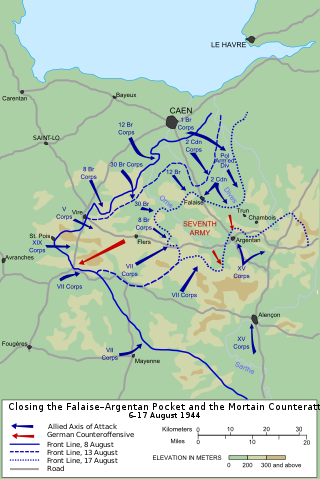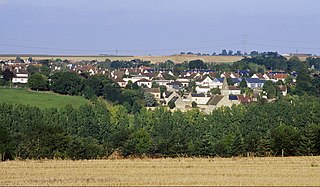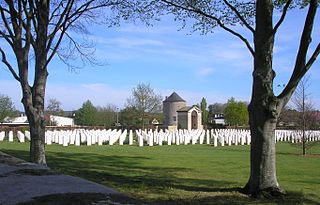
Operation Totalize was an offensive launched by Allied troops in the First Canadian Army during the later stages of Operation Overlord, from 8 to 9 August 1944. The intention was to break through the German defences south of Caen on the eastern flank of the Allied positions in Normandy and exploit success by driving south, to capture the high ground north of the city of Falaise. The goal was to collapse the German front and cut off the retreat of German forces fighting the Allied armies further west. The battle is considered the inaugural operation of the First Canadian Army, which had been activated on 23 July.

Bretteville-sur-Laize is a commune in the Calvados department in the Normandy region in northwestern France.

Cintheaux is a commune in the Calvados department in the Normandy region in northwestern France.

Hottot-les-Bagues is a commune in the Calvados department and Normandy region of north-western France.

The Falaise pocket or battle of the Falaise pocket was the decisive engagement of the Battle of Normandy in the Second World War. Allied forces formed a pocket around Falaise, Calvados, in which German Army Group B, consisting of the 7th Army and the Fifth Panzer Army, were encircled by the Western Allies. The battle resulted in the destruction of most of Army Group B west of the Seine, which opened the way to Paris and the Franco-German border.

The arrondissement of Caen is an arrondissement of France in the Calvados department in the Normandy region. It has 201 communes. Its population is 384,540 (2016), and its area is 1,595.7 km2 (616.1 sq mi).

The Battle for Caen was a military engagement between the British Second Army and the German Panzergruppe West in the Second World War for control of the city of Caen and its vicinity during the Battle of Normandy.

The Ardenne Abbey massacre occurred during the Battle of Normandy at the Ardenne Abbey, a Premonstratensian monastery in Saint-Germain-la-Blanche-Herbe, near Caen, France. In June 1944, 20 Canadian soldiers were massacred in a garden at the abbey by members of the 12th SS Panzer Division Hitlerjugend over the course of several days and weeks. This was part of the Normandy Massacres, a series of scattered killings during which up to 156 Canadian prisoners of war were murdered by soldiers of the 12th SS Panzer Division during the Battle of Normandy. The perpetrators of the massacre, members of the 12th SS Panzer Division, were known for their fanaticism, the majority having been drawn from the Hitlerjugend or Hitler Youth.

Operation Spring was an offensive operation of the Second World War conducted by II Canadian Corps during the Normandy campaign in 1944. The plan was intended to create pressure on the German forces operating on the British and Canadian front simultaneous with Operation Cobra, an American offensive. Operation Spring was intended to capture Verrières Ridge and the villages on the south slope of the ridge. The German defence of the ridge contained the offensive on the first day and inflicted many casualties on the Canadians.

The Bény-sur-Mer Canadian War Cemetery is a burial ground containing predominantly Canadian soldiers killed during the early stages of the Battle of Normandy in the Second World War. It is located in, and named after, Bény-sur-Mer, in the Calvados department, near Caen, in lower Normandy. As is typical of war cemeteries in France, the grounds are landscaped and kept. Contained within the cemetery is a cross of sacrifice, a monument typical of memorials designed by the Commonwealth War Graves Commission.

The Battle of Verrières Ridge was a series of engagements fought as part of the Battle of Normandy, in Calvados, during the Second World War. The main combatants were two Canadian infantry divisions—with additional support from the Canadian 2nd Armoured Brigade—against elements of three German SS Panzer divisions. The battle was part of the British and Canadian attacks south of Caen, and took place from 19 to 25 July 1944, being part of Operation Atlantic and Operation Spring.

Saint-André-sur-Orne is a village in the Calvados department in the Normandy region in northwestern France.
Brigadier-General Edward Alfred Charles Amy, DSO, OBE, MC, CD was a Canadian soldier who fought in World War II. He is one of Canada's most decorated soldiers.

Ranville War Cemetery is a Second World War cemetery of Commonwealth soldiers in France, located in Ranville, 10 km (6.2 mi) north east of Caen, Normandy. The cemetery contains predominantly British soldiers killed during the early stages of the Battle of Normandy. A large proportion of those interred were members of the British 6th Airborne Division. The cemetery is maintained by the Commonwealth War Graves Commission.

Banneville-la-Campagne War Cemetery is a Second World War cemetery of Commonwealth soldiers located close to the commune of Banneville-la-Campagne, 11 km (6.8 mi) east of Caen, Normandy, France. The graveyard contains 2,175 graves of which 140 are unidentified The cemetery is maintained by the Commonwealth War Graves Commission.

Hermanville War Cemetery is a Second World War cemetery of Commonwealth soldiers in France, located 13 km north of Caen, Normandy. The cemetery contains 1,003 commonwealth war graves.

Hottot-les-Bagues War Cemetery is a British Second World War cemetery of Commonwealth soldiers in France, located 15 km south-west of Bayeux, Normandy. The cemetery contains 1,005 commonwealth war graves and 132 German war graves.

Grainville-Langannerie Polish war cemetery is the only Polish Second World War cemetery in France. It is located 17 km south of Caen, Normandy, and contains 696 Polish war graves. It is one of seven military cemeteries now maintained by the French state.
The Battle for Hill 140 was fought on 9 August, 1944 as part of Operation Totalize between a battle group from the 4th Canadian Division and German troops, mainly from the 12th SS Panzer Division "Hitlerjugend". It unfolded some miles east of the village of Estrées-la-Campagne, Normandie, when during a night attack, the Canadian troops deviated from the axis of advance, occupying an area contrary to the orders of their own command. The consequence of the mistake was the complete destruction of the Canadian combat group by a German counterattack that lasted several hours. It was an unprecedented case during the Normandy campaign, and probably the entire World War II, for such a large force to lose track of the terrain, lose its way and consequently be completely wrecked.



















